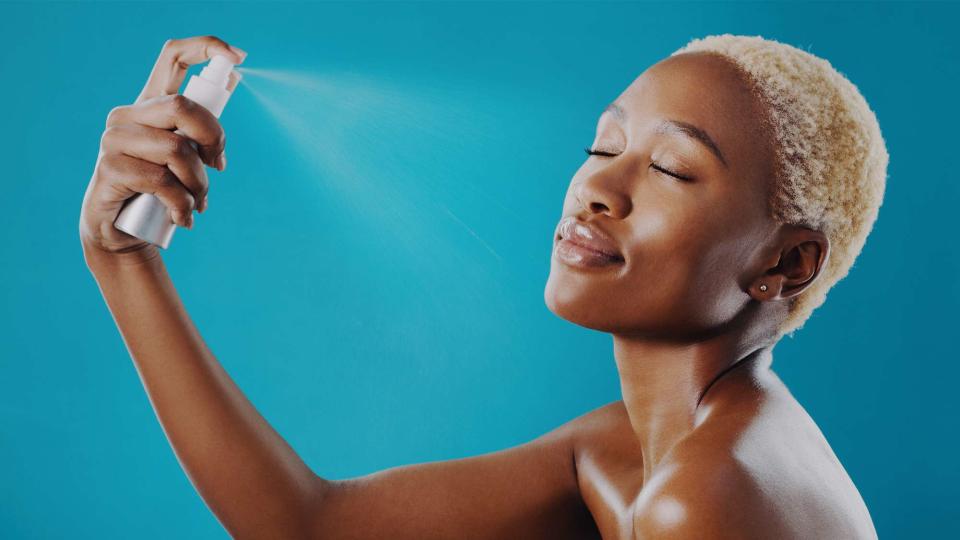Does Face Mist Actually Do Anything—and When Is the Best Time to Apply It?
We asked derms to decode all the mist-eries (sorry) around face mist.

Delmaine Donson/Getty Images
Ever since Mario Badescu’s pink facial spray became viral on social media, face mists have become its own category in skin care. From refreshing mists to setting sprays, there are a lot of products to choose from—but does the product do anything beyond offering a funner form of delivery? Or are the bottles just overpriced bottles of water? We tapped in dermatologists to find out.
What are face mists?
“Face mists are best for extra hydration, preparation for skin care, and to add other nutrients or antioxidants to rejuvenate your skin,” says Mamina Turegano, MD, board-certified dermatologist. “All these benefits can also be helpful for keeping the skin barrier healthy.”
Just as with all skin care, reading and knowing the ingredients in each product is key. “Facial mists are mostly water-based sprays that are used to apply a variety of ingredients to the skin with the most common purpose being to hydrate the skin, but there can be other benefits too,” says Rachel Nazarian, MD, board-certified dermatologist in New York City. “Most hydrating mists include ingredients such as hyaluronic acid, but others contain additional calming, anti-inflammatory ingredients that soothe irritated skin. These are great for people with dry or sensitive skin conditions, or those who suffer from eczema and rosacea.”
Essentially, a face mist is the closest thing to a sprayable serum. Everyone can derive a hydrating benefit, but those with dry or dehydrated skin are most likely to see a big immediate difference in their skin. “It's not an essential staple of the skincare regimen, but a facial mist can enhance other aspects of your skincare, improving absorption of ingredients and sealing them in,” Dr. Nazarian says. And of course, there’s the added benefit of being easier to apply over makeup and throughout the day. Dr. Turegano recommends using a face mist if you need a quick way to moisturize on the go.
If you have dry skin, a good face mist can be an additional moisturizing agent throughout the day but if you have oily skin, there are benefits too: face mist can moisturize your skin without adding heaviness. And, those with combination skin can find a happy medium, using the face mist when they need it and a stronger, thicker moisturizer at night.
When is the best time to apply face mist?
As for when to apply face mist, Dr. Nazarian has two recommendations: “For hydrating or anti-inflammatory mists, I prefer to use them earlier in the skin care regimen, preferably after cleansing. Those with free-radical fighting antioxidants can be used just about anytime, even towards the end of the skin care routine.”
Dr. Turegano agrees that different application times can have different effects. “I think it can be helpful to use fact mist prior to applying skin care because skin care absorbs well on damp skin.” Since the mist dampens the skin, you can expect it to increase the absorption of subsequent products, making your entire routine more effective.
That being said, you can use face mists on “dirty” skin, i.e. over makeup or on skin that hasn’t been recently cleansed.“Some mists contain refreshing cleansing ingredients that can rejuvenate your skin without having to rinse,” Dr. Nazarian says. “These are often great choices for midday application.”
In other words, whether you want to boost your other skincare products or need a midday skincare refresh, face mist can have many benefits. “The biggest benefit of a face mist is during environments when your skin is exposed to exceptionally high-stress states: the airplane, the beach, or a long day in a hot muggy city,” says Dr. Nazarian. “The little spritz can make your stressed skin feel revived immediately.” Just one caveat to keep in mind: If a mist doesn’t have any humectants or occlusives, it is possible that the skin isn’t able to hold on to moisture, as water can evaporate off skin and leave it drier. Make sure to scan the ingredients and pick one that has something like hyaluronic acid to seal in hydration.
For more Real Simple news, make sure to sign up for our newsletter!
Read the original article on Real Simple.

